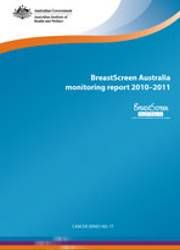Summary
BreastScreen Australia aims to reduce illness and death resulting from breast cancer through organised screening to detect cases of unsuspected breast cancer in women, thus enabling early intervention. BreastScreen Australia targets women aged 50-69 for free 2-yearly screening mammograms.
This report is the latest in the BreastScreen Australia monitoring report series, which is published annually to provide regular monitoring of national participation and performance for BreastScreen Australia. The report provides data for the 2010-2011 period of participation in BreastScreen Australia, as well as the latest available data on breast cancer incidence (2009) and mortality (2010).
The following statistics refer to the latest data available for women aged 50-69.
How many women were diagnosed with, or died from, breast cancer?
In 2009, there were 7,022 new cases of invasive breast cancer diagnosed in Australian women aged 50-69. This is equivalent to 288 new cases per 100,000 women.
Breast cancer incidence has remained steady at around 290 per 100,000 women since 2003. In 2010, a total of 1,098 women aged 50-69 died from breast cancer, equivalent to 43 deaths per 100,000 women. This makes breast cancer the second most common cause of cancer-related death for Australian women after lung cancer.
Breast cancer mortality decreased from 68 to 43 per 100,000 women between 1991 (when BreastScreen Australia began) and 2010. This has been attributed to the early detection of cancers through BreastScreen Australia, along with advances in management and treatment.
How many women participated in BreastScreen Australia?
In 2010 and 2011, more than 1.3 million women aged 50-69 had a screening mammogram through BreastScreen Australia. This was 55% of women in the target age group.
Lower participation occurred in Very remote areas, among Indigenous women, and among women who reported that they speak a language other than English at home.
While participation increased with improving socioeconomic status, this trend was small, with all socioeconomic groups recording participation rates between 53% and 55%.
The difference between Aboriginal and Torres Strait Islander and non-Indigenous women was greater, with 36% of Aboriginal and Torres Strait Islander women having a screening mammogram in 2010-2011, compared with 54% of non-Indigenous women.
How many women were recalled for further investigation?
In 2011, 11% of women screening for the first time were recalled for further investigation;
4% of women attending subsequent screens were recalled.
How many women had a small breast cancer detected?
Small breast cancers (≤15 mm in diameter) are associated with better treatment options and improved survival. A high proportion of invasive breast cancers detected were small in 2011: 50% of invasive breast cancers detected in those attending their first screen, and 63% in those attending subsequent screens.



